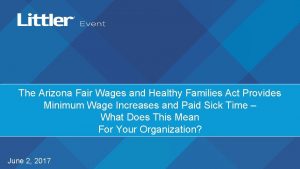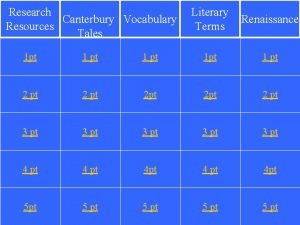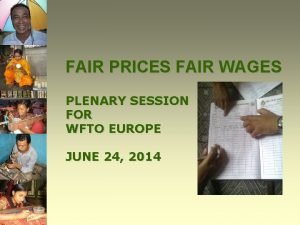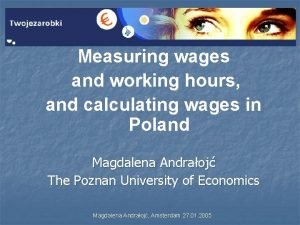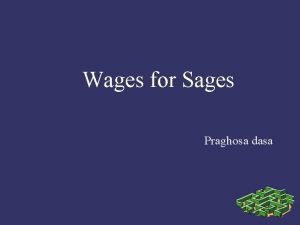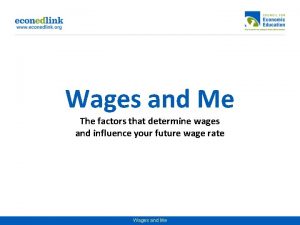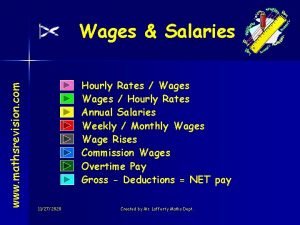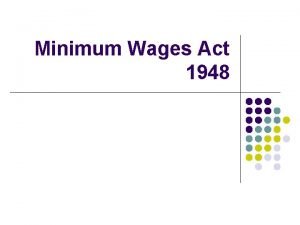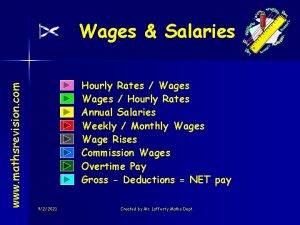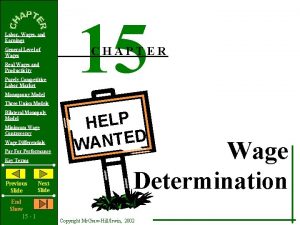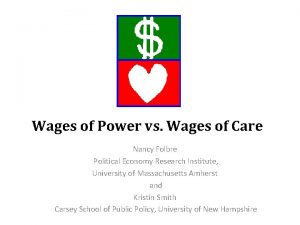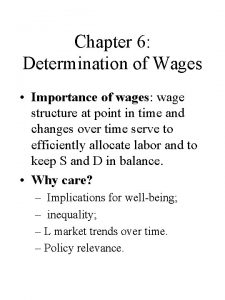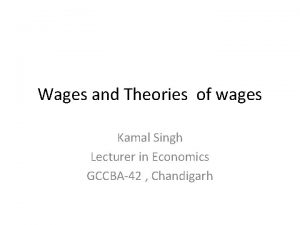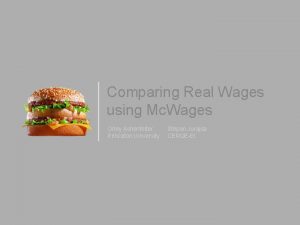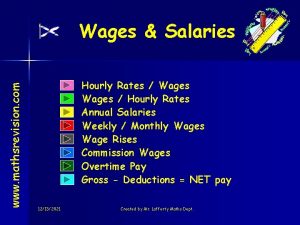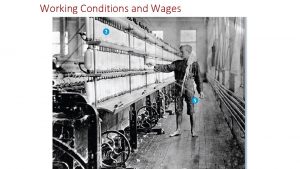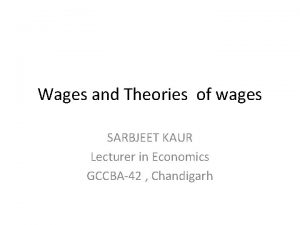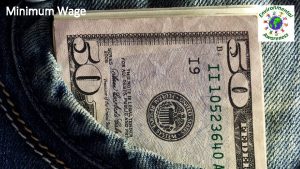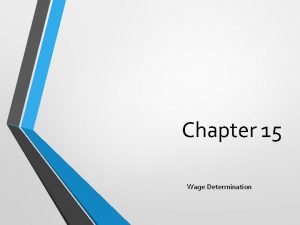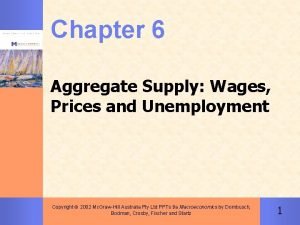FAIR PRICES FAIR WAGES LIVING WAGES the most






















- Slides: 22

FAIR PRICES, FAIR WAGES & LIVING WAGES: the most important conversation in Fair Trade today…

Introduction - DEFINITIONS - Background : WHY this working group - It’s a scary journey with lots of ‘potholes’… Living Wage Calculators - DAWS & SA 8000 : Frans Papma - other (unsuitable) Living Wage Calculators : Verena Albert Mitigating the IMPACT of Living Wages : Rain Morgan Beyond this working group… Conclusion

DEFINITIONS A FAIR PRICE is one that has been negotiated through dialogue and transparent price setting, which includes: an analysis of production and trade costs, a fair wage and provides a fair profit. A FAIR WAGE represents an equitable, negotiated share of the value chain of the product and presumes the payment of a least a living wage. A LIVING WAGE is the remuneration received for standard working hours (without overtime), which is sufficient to meet the basic needs of an individual and his/her dependents, and allow for some savings and/or discretionary expenditure. Elements of a decent standard of living include food, water, housing, education, health care, transport, clothing and other essential needs, including provision for discretionary expenditure. Fair Price Fair Wage Living Wage

WHY this Working Group? Why have this conversation at all? To arrive at a FAIR PRICE, we need to define a FAIR WAGE, and to define a FAIR WAGE, we need to define a LIVING WAGE… and this is where the problem lies. Consumers and customers EXPECT transparency and accountability – and they EXPECT that Fair Traders are paying at least a Living Wage.

Living Wages as a fundamental principle in fair trading is not NEW – people have been talking about it for more than 20 years… Fair Trade is ONE voice in the GLOBAL conversation: Academics, Formal Business, BIG business, small business, governments, the alternative economic bodies (sharing economy, impact investors, bio-based economy, etc). The trend in the conversations of the conscience economists is towards more transparency, more accountability : a direct line in real numbers between the producers and the consumers – “wage rich prices”; “true cost pricing” The GOOD news: it is creating MOMENTUM and broad based awareness… The BAD news is that we cannot afford NOT to join the conversation. … not if we expect to be taken seriously as ‘the’ voice of Fair Trade.

The ‘Elephant in the Room’… In ALL the discussions with members, interviews and workshops, ONE factor prevailed: EVERYONE fears the implications of implementing Living Wages. “Fear is the enemy of the process, and the challenge is going to be to manage the fears and work it into the process…” The FOCUS of the fear is MONEY and TRADE : all the ultimate demons of fair trading are here – some of the most difficult conversations between producers and buyers lie ahead…

Producers fear they will have to bear the brunt of the increases in wages, – while agencies up the chain assume token shares of the burden and make bigger profits in the process. Not all the business producers do, is Fair Trade business… (for most producers it is only PART of their business) The conventional market is getting more competitive, more cut -throat, more ruthless. Will some producers be forced into two-tier wage systems - one for Fair Trade and one for conventional trade? Most producers have no idea how big the GAP is – and they’re almost too afraid to find out… Buyers fear the press, and social media (who are looking for proof that fair trade – as most consumers understand it – is not ‘fair’). Buyers fear criticism of their peers and their customers : everyone wants real numbers, real transparency, evidence of real impact and PROOF of fairness. Producers fear WORKERS will – once they know what the living wage is – demand immediate increases… (also labour unrest, disruption in production etc) Buyers fear an increase in prices in an already hyper-competitive market and a sluggish economy…

WARNING: POTHOLES! The biggest mistake WFTO can make, is to do nothing : our critics, fair trading peers and competitors are watching with interest… If we cannot PROVE we’re paying Living Wages, we cannot claim to be paying Fair Wages and Fair Prices… Danger is: making promises we cannot possibly keep. We need a well communicated, credible, clearly defined strategy on a realistic time-line : no one expects results tomorrow – but if in 5 years from now, we are still talking… #1 PRIORITY = GUARDING WFTO’S FAIR TRADING REPUTATION (we are WFTO – we are the guardians…)

FPFW WATCH SQUAD: Monitor activity of & engage broader Fair Trade community ; liaise with Working Groups & advise board… • Identify members & liaise with support agencies. • Test the Living Wage Calculators : DAWS or SA 8000 and a custom Fair Price Calculator. • Construct a BASIC gap analysis and bridging plan (including strategies to mitigate impact of Living Wages). • Report findings to WFTO Board and advise if 4 year implementation is appropriate. FPFW IMPLEMENTATION Working Group FPFW Pilot Working Group 4 year IMPLEMENTATION period Pilot with 15 members: ASSESSMENT POINT – are we on course? 3 per Region 2015 2016 2017 2018 2019 Beyond this working group… ALL MEMBERS COMPLIANT 2020

Living Wages calculation systems: Note: Its important to distinguish between Living Wage calculators and Price calculators ! Calculate the Living Wage: § Method: calculate the daily cost of food for an adult, and multiply with a number to cover non-food costs and family size. § Use a food basket, with at least 2300 Kcal per day.

Calculate food costs for 1 adult: • Find food basket • Find Kcal per gram for every food item • Find the price per kilo of every food item • Fill that in in the form • Adjusted automatically for 2300 Kcal per day • Now we have the daily cost of food for 1 adult

Convert this to the need of an average family (family size and nonfood items) SAI Find average family size example: 4 DAWS Find country classification Low Income (4, 3) Middle Income (5, 0) Find ratio food/non-food costs example: 45% / 55% Now we have LW Find Minimum Wage The table compares Minimum Wage and Living Wage Calculate the price of your products with LW included.

Living wage calculators we considered but rejected… Asia Floor Wage Alliance: § Central demand: call for a Living Wage led to “Asia Floor Wage calculation” for garment workers across Asia. Based on cost of food basket → benchmark based on common purchasing power Pros: § Benchmarks are agreed in consultation with workers + wages are very high and therefore beneficial for the workers Cons: § Wage levels of AFW very high and exceed existing wages many times over → often not feasible! § AFW calculation cannot be simply applied to other regions e. g. Africa

Wage Ladder: “JO-IN project” invented “Wages Ladder tool” → shows actual wages against any number of benchmarks (e. g. poverty line, minimum wage), usually found within companies. → Allows comparison of wages + demonstrates wage trends over time, BUT: not a tool to calculate appropriate Living Wages Fair Wage calculator: Its an online costing and pricing tool → comparison of wages or piece rates with existing benchmarks (Minimum Wage, Poverty Lines etc. ). Good World Solutions adopted “Minimum Wage + 10%” as a benchmark for a Living Wage → Calculation tool only gives information about the proportion of the payment to existing benchmarks, BUT: no information/calculation about a Living Wage → “Minimum Wage + 10%” as Living Wage is not appropriate as it is too low

Global Living Wage (Wage. Indicator): Wage. Indicator introduced a concept of a globally comparable living wage. The Living Wage calculation includes: cost of food + housing + transportation; 20 % margin → bases on data from Wage. Indicator “Cost of Living Surveys”. → LW calculations base (more or less) on the same data as SA 8000 and DAWS, BUT: as the tool is quite new it is important to evaluate first Approach from Fairtrade International, SAI, RA, UTZ etc. : Living wage working group: goal → work on the methodology, promotion and implementation of a living wage for workers. Implementation of 4 pilots – focus on agricultural products. The Living Wage calculation includes: cost of food + rent/housing + other expenses + margin → family size and number of full-time workers needs to be considered → Great for large agriculture BUT: less appropriate for rural handicraft, and small, peri-urban groups.

Mitigating the IMPACT of Living Wages… # 1 FEAR is that implementing Living Wages at producer level will have a catastrophic effect on the selling price and make products unviable in the market. The only solution is a ‘whole chain’ approach over a number of years – if the chain is a Fair Trade chain, it should not be too hard… If the chain is a conventional market chain, the ‘value propositions’ for the agencies will have to be real and very clear. It might be time to start thinking of ‘profit’ – not in terms of ‘margins’ - but in terms of earnings, value created, benefits to people, planet and global prosperity…




WORKERS CURRENT SCENARIO PRODUCER ORGANISATIONS AGENTS TRANSPORT & TAXES (NON-NEGOTIABLES) IMPORTER RETAILER WAGES HALF OF LW YEAR 1 20% YEAR 2 17% YEAR 3 14% YEAR 4 12, 5% YEAR 5 9% OVERALL IMPACT LW ACHIEVED: WAGES DOUBLED! CONSUMER RETAIL PRICE ALL (EXCEPT TAXES AND TRANSPORT) SACRIFICE 0, 5% MARGIN : ONLY RETAIL LOSES 1 c ON $6, 17 – REAL EARNINGS FOR EVERYONE ELSE STAYS SAME. EXTRA COMES FROM INCREASED EFFICIENCIES. +1% +2% ALL AGENCIES ‘SACRIFICE’ 3 c PER YEAR : IN REAL TERMS ONLY MARGIN IS SACRIFICED – EARNING STAY THE SAME. +2% +2% MOST MARGIN SACRIFICED BUT REAL EARNINGS INCREASED NO LOSS OF REVENUE – ONLY MARGIN REAL ‘LOSS’ = 1 c on $6, 17 in YEAR 1 LESS THAN 10% INCREASE IN 5 YEARS.

Living Wages were achieved in 5 years… and that’s not all: • Consumer paid less than 10% more – it wasn’t a ‘blind’ increase: they knew why – and campaigns built awareness and goodwill. • SPIN-OFF ADVANTAGES: Increased awareness of WFTO label – differentiator in market; momentum of campaigns increased sales; negotiations and collaborative efforts strengthened relationships. Take your ‘bottom line’ to the board – not your margins – and include the ‘people profits’… Be open, be honest and involve all the ‘agencies’ : it’s an on-going, circular conversation, not a once off, ‘up and down’ conversation. Responsibility of the Workers and Producer Organisations: • ALL need to commit to maintaining and improving efficiencies – waste at producer level ‘costs’ up the chain. • ACTIVELY participate in campaigns and social media : awareness raising needs to happen at all levels and all the time – a groundswell of conversations are needed.

WFTO HAS TO BE SEEN TO ENGAGE FAIR PRICES, FAIR WAGES AND LIVING WAGES IN A MEANINGFUL WAY: We have no choice – our Fair Trading credentials are on the line… We don’t have to be perfect IMMEDIATELY – but we have to have a PUBLIC plan – a carefully considered strategy to achieve what we’ve promised: Without Living Wages, we cannot claim we’re paying Fair Prices and Fair Wages.
 Prop 206 arizona pros and cons
Prop 206 arizona pros and cons The smallest living unit within the human body is
The smallest living unit within the human body is Living and nonliving things venn diagram
Living and nonliving things venn diagram Is a moss living or nonliving
Is a moss living or nonliving Living non living dead
Living non living dead Literary devices in macbeth
Literary devices in macbeth Examples of fair is foul and foul is fair in macbeth
Examples of fair is foul and foul is fair in macbeth Fair is foul and foul is fair
Fair is foul and foul is fair 14 lines
14 lines What is syntax rhetorical device
What is syntax rhetorical device Foul is fair and fair is foul literary device
Foul is fair and fair is foul literary device Significato fair play
Significato fair play Vẽ hình chiếu đứng bằng cạnh của vật thể
Vẽ hình chiếu đứng bằng cạnh của vật thể Bổ thể
Bổ thể độ dài liên kết
độ dài liên kết Môn thể thao bắt đầu bằng từ đua
Môn thể thao bắt đầu bằng từ đua Sự nuôi và dạy con của hổ
Sự nuôi và dạy con của hổ điện thế nghỉ
điện thế nghỉ Thế nào là sự mỏi cơ
Thế nào là sự mỏi cơ Trời xanh đây là của chúng ta thể thơ
Trời xanh đây là của chúng ta thể thơ Gấu đi như thế nào
Gấu đi như thế nào Số nguyên tố là số gì
Số nguyên tố là số gì Thiếu nhi thế giới liên hoan
Thiếu nhi thế giới liên hoan
